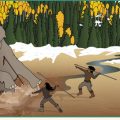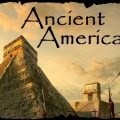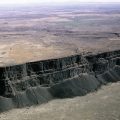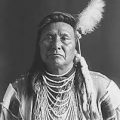
The present-day state of Idaho is a totally arbitrary area defined by political concerns unrelated to American Indian history. With regard to American Indian cultures, Idaho straddles two distinct culture areas: (1) the Plateau in the north and (2) the Great Basin in the south. The climatic changes from 6000 BCE to 3000 BCE impacted the Indian people in these two areas differently. In the Plateau area, this period is called the Middle Period by archaeologists. Briefly described below are some of the archaeological sites which date to this era.
Owl Cave: by 6000 BCE, Indian people were using Owl Cave as a site for the systematic killing of buffalo. According to archaeologist B. Robert Butler in the Handbook of North American Indians:
“Apparently, each of the Owl Cave kills resulted from a well-planned and coordinated undertaking in which herds of 30 or more Bison antiquus were induced or driven into the cave, dispatched with spear thrust into the body cavities, and then systematically butchered.”
The now extinct Bison antiquus is generally considered to be the ancestor to the modern Bison bison bison. This extinct species was 15% to 25% larger than the modern bison.
Centennial Mountains: by 6000 BCE, Indian people were hunting and gathering in the Centennial Mountains where they left behind hundreds of camp sites.
Quarry Sites: by 5800 BCE, Indian people were using a number of quarry sites along the upper Salmon and Pahsimeroi rivers. These are located at an elevation of 7,800 feet. Since not all stone can be used for making stone tools, sites where good stone can be easily obtained were very important.
Bernard Creek Rockshelter: by 5250 BCE, Indian people occupied the Bernard Creek Rockshelter in Hells Canyon.
Birch Creek: by 5200 BCE, Indian people were now living in the Birch Creek area. The climate at this time was arid and the lakes in the area had been reduced to intermittent marshes.
Kirkwood bar site: by 5100 BCE, Indian people were now living at the Kirkwood bar site in Hells Canyon.
DeMoss site: by 5000 BCE, Indian people had established a cemetery at the DeMoss site in the south-central portion of the state.
Root Plants: by 4400 BCE, the Indian people in the eastern Plateau Area (this would include what is today northern Idaho) were using root plants. Earth ovens were being used in processing these plant foods. By 3500 BCE, camas was in regular use in this area.
Village: by 4050 BCE, the Nez Perce established a village site on the Clearwater River. Economic activities at this time included salmon fishing.
Little Salmon River: about 4015 BCE, 22 people were buried at an Indian graveyard near the Little Salmon River.
Island Park Reservoir: by 4000 BCE, Indian people began to live in the Island Park Reservoir area.
Weiser River: about 3840 BCE, two women, and four children were buried in a mass grave near the mouth of the Weiser River.
Challis: by 3380 BCE, near present-day Challis, Indian people began using a buffalo jump to kill buffalo.
Burials: by 3200 BCE, in southwest Idaho, Indian people were buried with elaborate grave goods, including red ochre, olivella shells, large biface points, dog skulls, pipes, hematite crystals, and tools.
Corn Creek: by 3000 BCE, Indian people began living in the Corn Creek area.




Leave a Reply